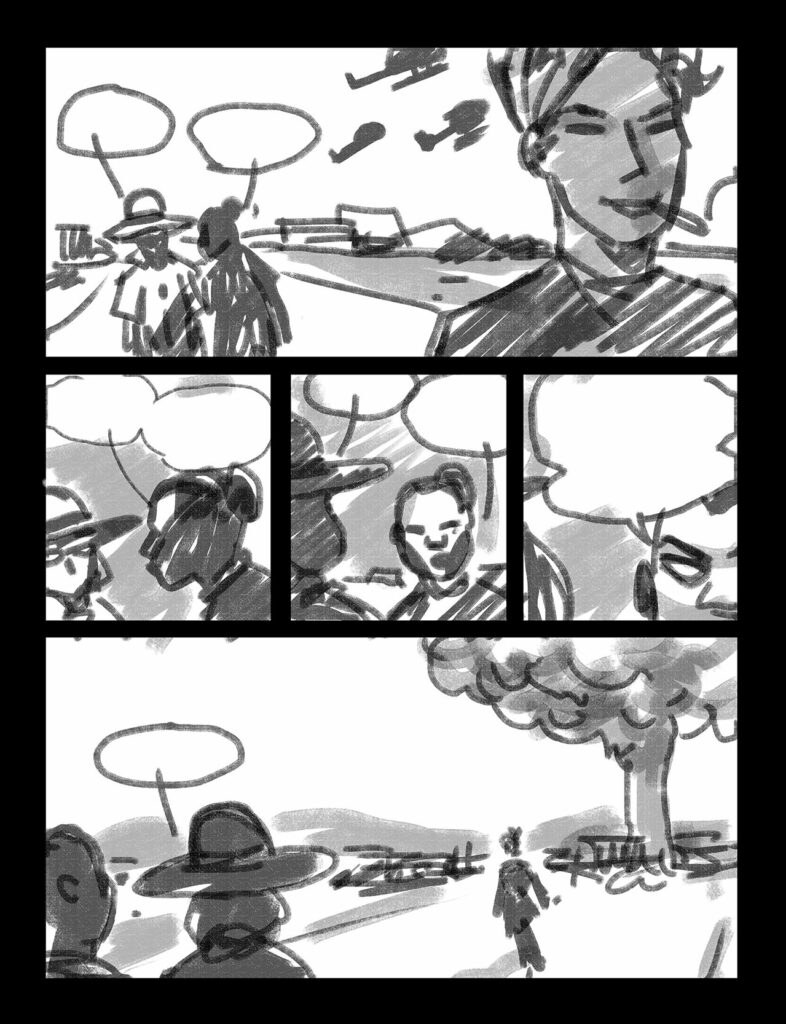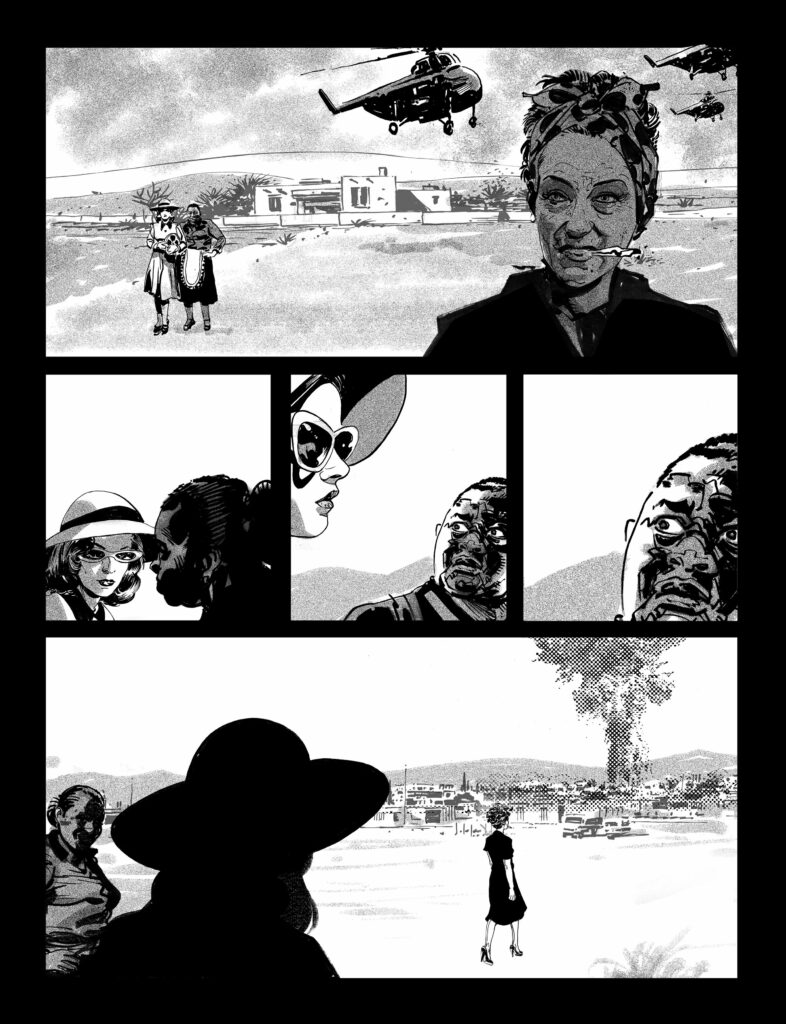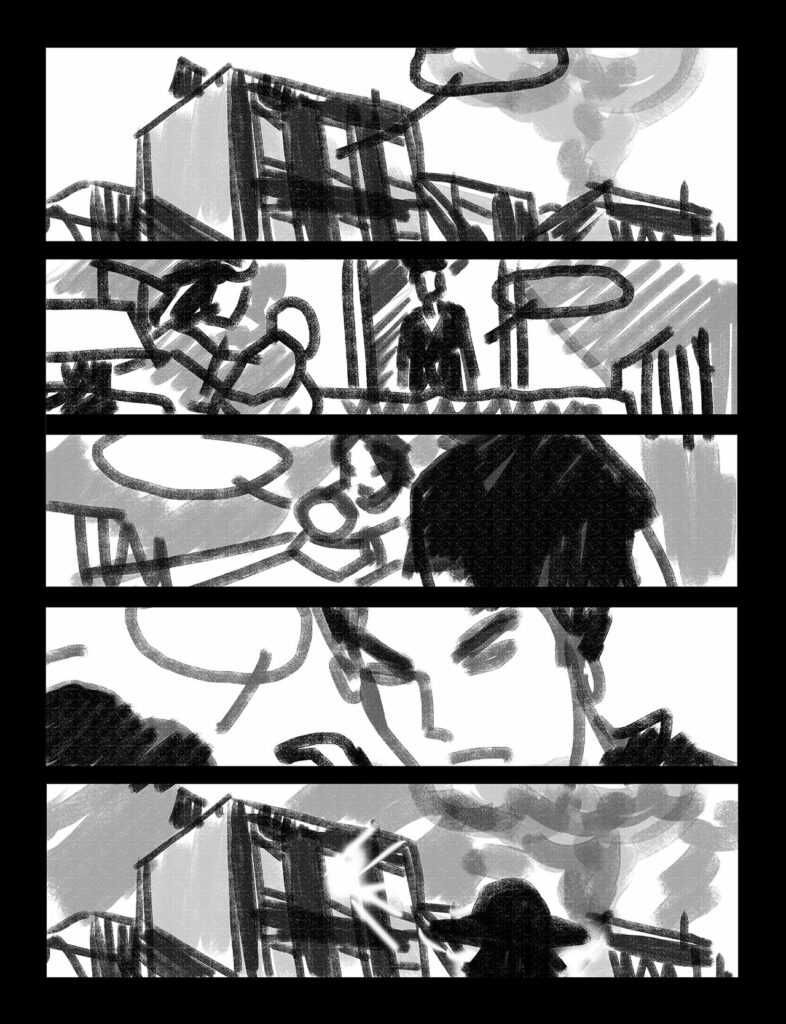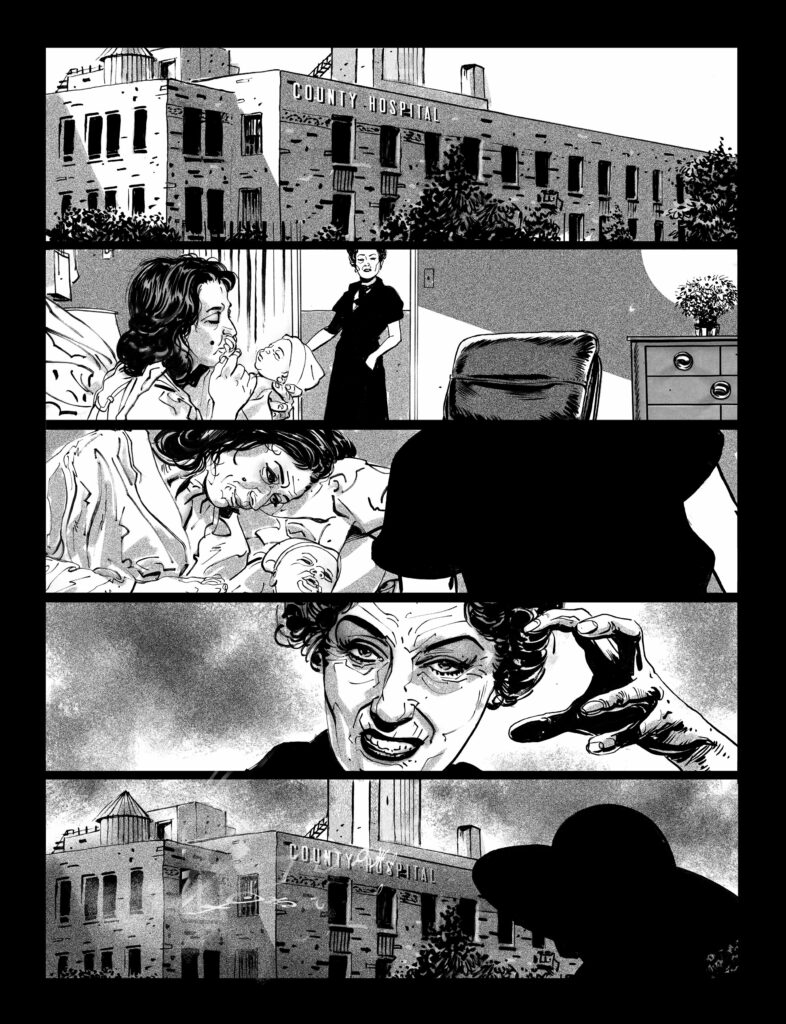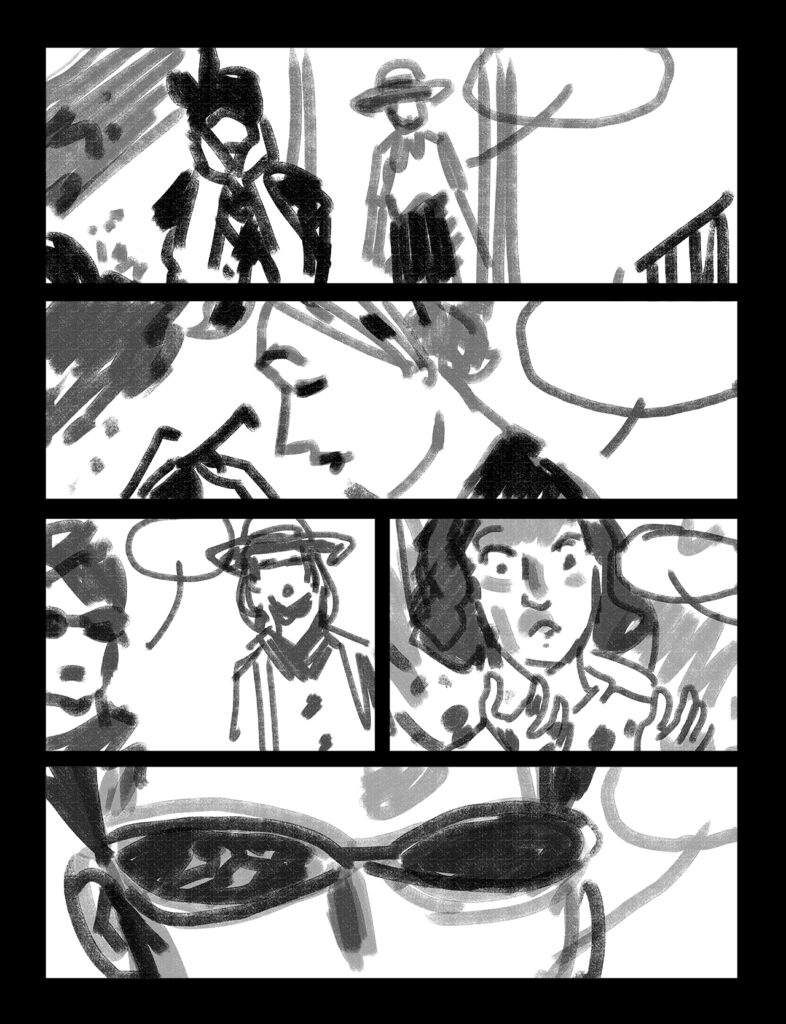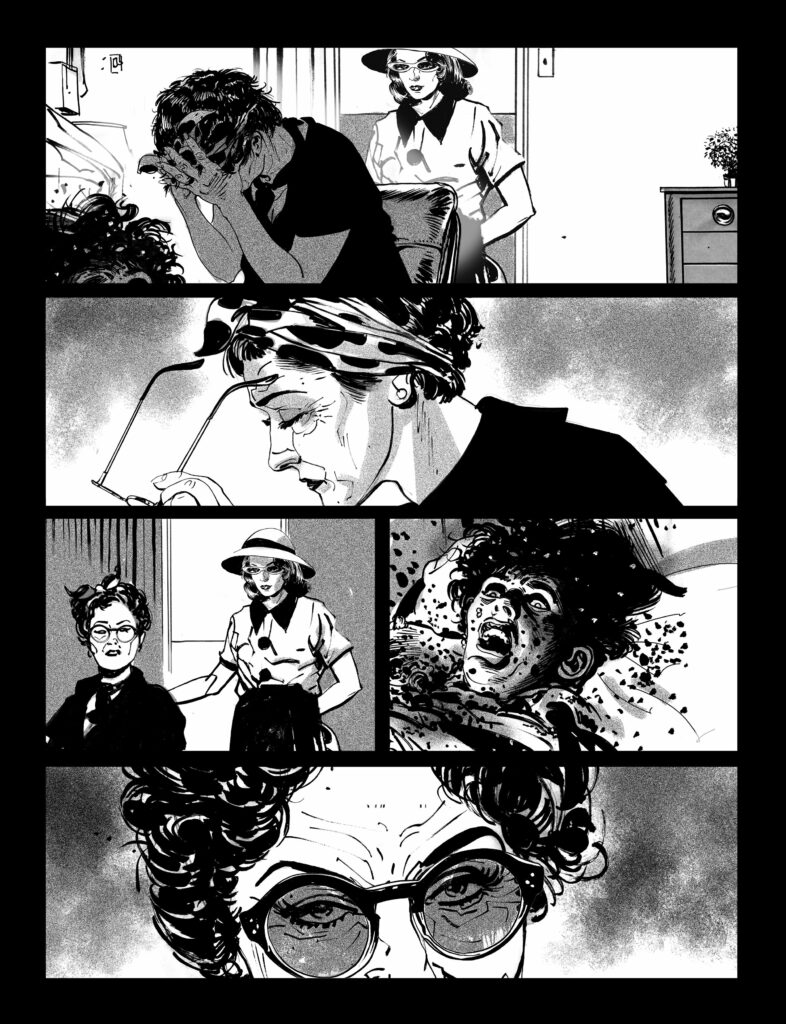Interview: Guy Adams and Jimmy Broxton’s Hope… In The Shadows Reel Two, ‘a conservatory extension of bonus horror’
5th December 2022
The magic infused noir horror of Hope… In The Shadows is reaching the end of Reel Two in the pages of the Prog right now – we talk to its court-creators Guy Adams and Jimmy Broxton.

Set in an alternate 1940s USA where magic is commonplace and WWII was won through occult means, Hope follows Mallory Hope, former New York cop turned Hollywood PI and magician who returned from the nightmares of war just to find that the nightmares came back with him.
With a demon attached to his soul and his wife seduced by magic while he was gone, vanishing and taking their young son with her, Hope knows the heavy cost being a practitioner of the dark arts can exact.
That was then. This is now. Reel One of Hope… In The Shadows saw Mallory called in to investigate a cursed film. Now, in Reel Two, Hope’s wife Alice is back. This is not the reunion Mallory was hoping for…
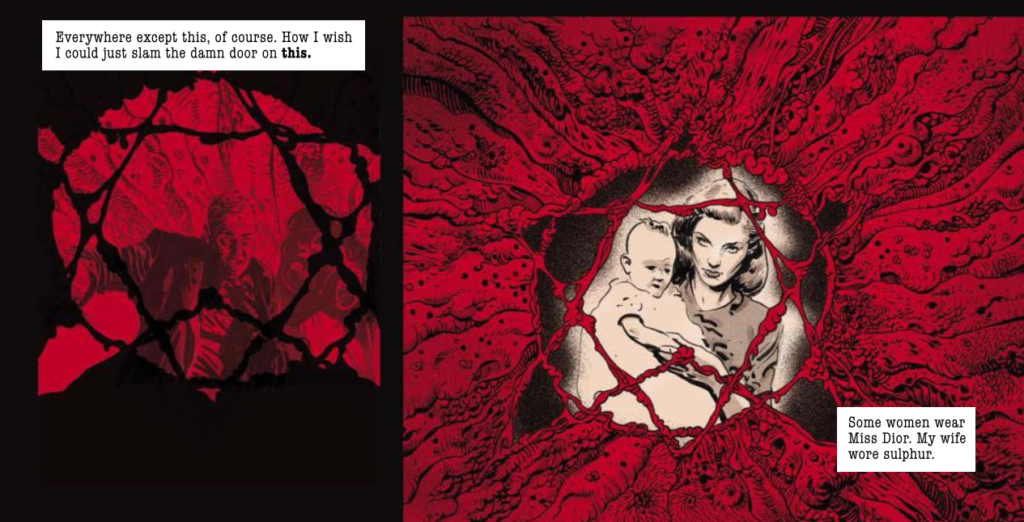
Guy, Jimmy, we’re currently deep into Hope… In The Shadows Reel Two in the Prog, continuing our nightmarish journey through this magic-infused post-WWII alt-America.
Reel one of this latest Hope had Mallory investigating a haunted/cursed film set, very much in the sort of ballpark of previous Hope storylines. But here in the second Reel, it’s gone a hell of a lot more expansive, a lot more worldly, and is busy switching between Mallory and his no longer missing wife Alice.
That first episode showed us just how dangerous and deadly she can be – those poor patrons of that doomed diner. It was also an opener that built up the tension perfectly, narrative and art just a superb example of how comics can do this sort of thing like no other.
Jimmy Broxton: Well, you are too kind, but it was great to have the opportunity to expand on what we had already seen, following Alice’s journey with the ‘MacGuffin” (a Hitchcock reference for ya), to new locations outside of the more familiar noir trappings. Sun-scorched desert locales, rattlesnakes, infinite highways, and the like. Pure Americana, but visual gold.
Guy Adams: The idea with this series was always to expand, not just in pure comics real estate (we’re twice the size, a conservatory extension of bonus horror). Ongoing series need to unfurl I think, to keep changing the stakes, the shape of the world.
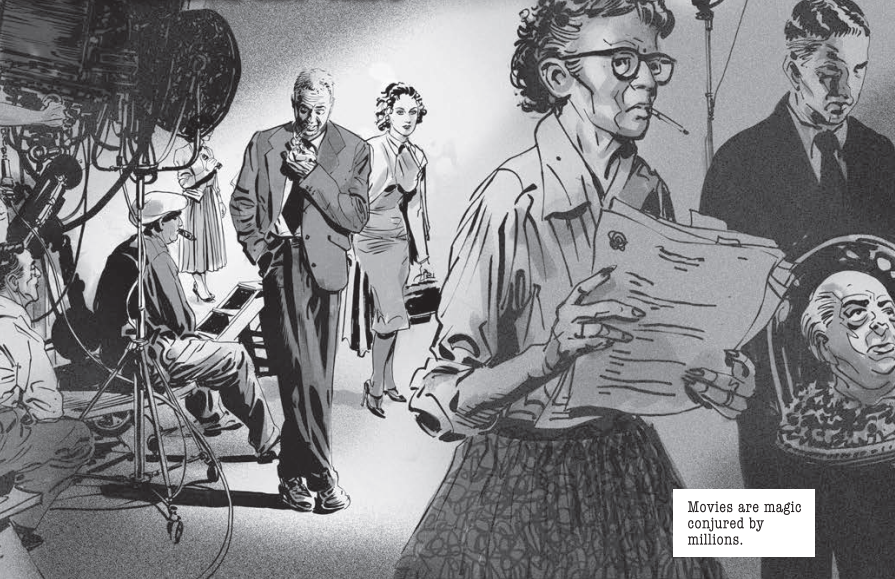
In a series that has, thus far, been confined to just Mallory Hope and his investigations, the second episode sees you getting into something far, far bigger – the nuclear threat, the coven, the President’s arrival… all very big ideas that we’re going to see, no doubt, developed in future episodes.
JB: In Hope we have always alluded to a real-world setting, Hope is, in effect an alternate history of post-war America with supernatural/occult overtones. It’s entirely consistent within that worldview to have “real world” historical protagonists interact directly with our fictional characters, as opposed to just seeing them in newspaper headlines or on theatre awnings.
We have Alice and her fellow coven-mates getting together and the most powerful man in the world quaking in his boots – what manner of things are you setting up here? And just how will poor Mallory Hope get involved?
JB: I couldn’t possibly comment.
Spoilsport! Okay, how about this then? From just those first couple of episodes, I’m getting the feeling that you’re building to a rather dreadful crescendo – are we looking at a possible end to the series and is it going to be going out in a magical/nuclear inferno?
JB: I couldn’t possibly comment on that either.
Dammit, two for two. Let’s try again one last time… So, how close am I to thinking that this series of Hope is feeling like the very last one?
JB: Or that.
Three strikes. That Jimmy Broxton doesn’t spill the beans!
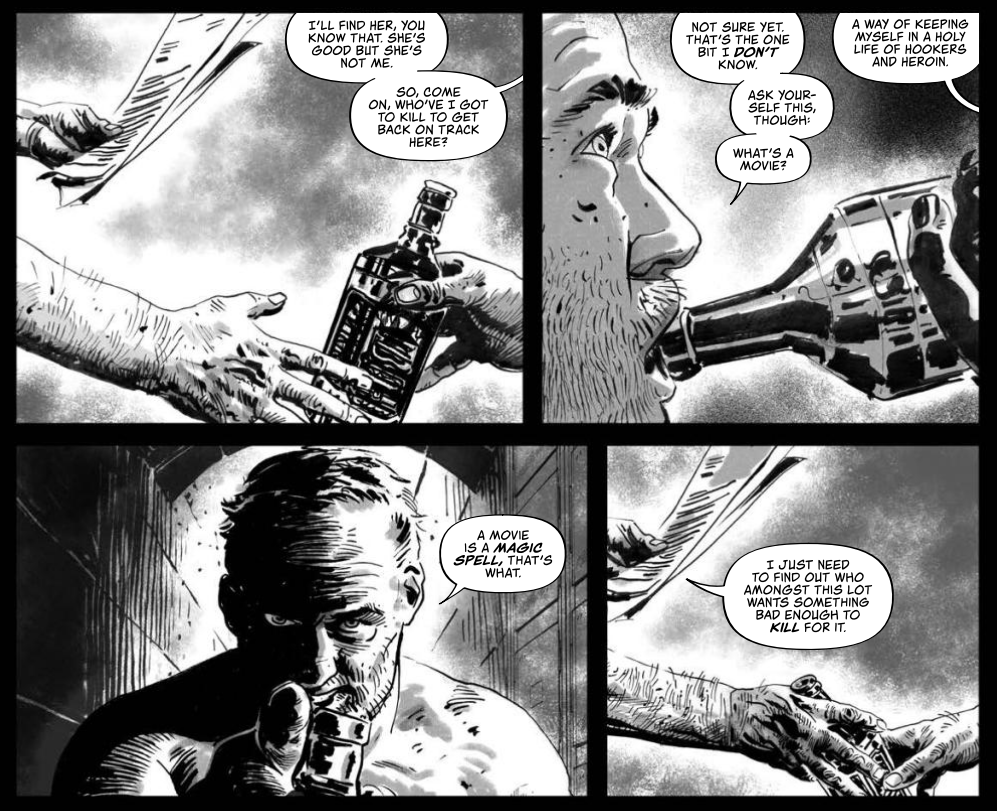
Okay then, what sort of things have you dreamed up for Hope‘s future?
JB: Guy hasn’t told me yet, but we do bounce ideas around. I’ll pitch in with things I’d like to see, or even just things I’d like to draw. I did suggest we turn the series into a trendy, drag-themed ultra-camp comedy, as Mallory (now pretending to be a woman), goes undercover to investigate a spate of gruesome murders on Broadway. Renaming it “Hopey – Does my Ass Look Big In This?” So far both Guy and Tharg have remained eerily silent.
GA: And intend to remain so.
Probably for the best.
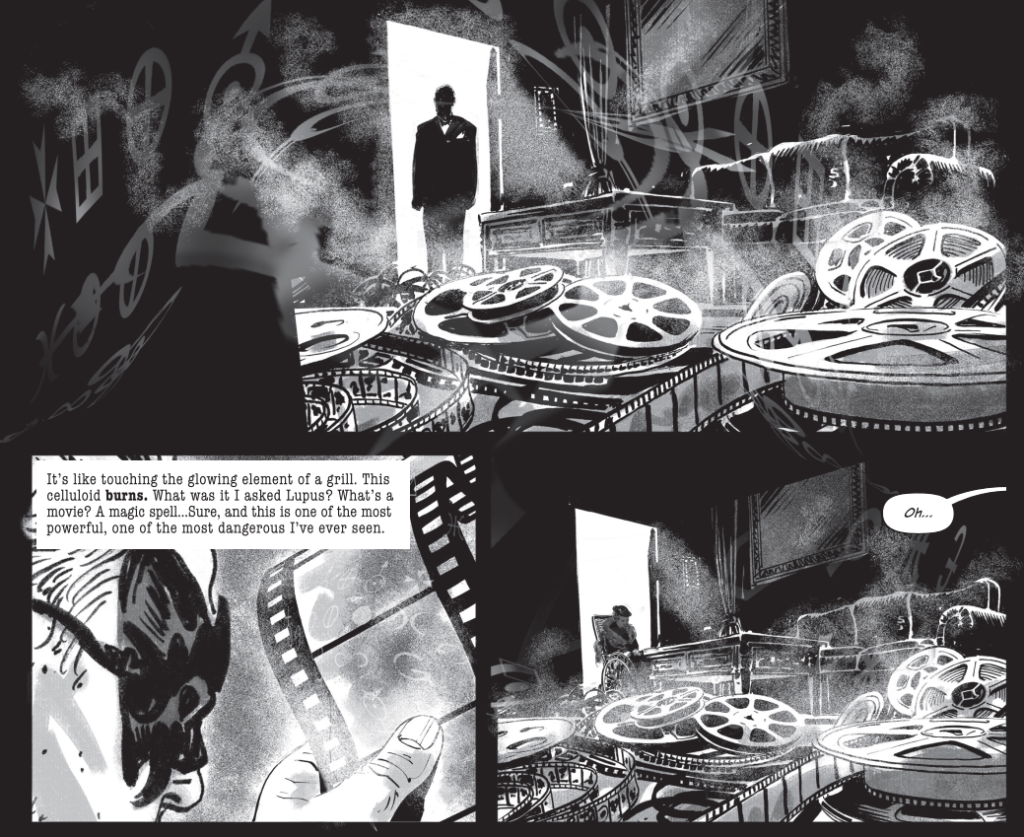
All the way through, Hope has been a series that’s visually led, with Jimmy’s artwork essential in setting the mood and the tone for a series that is, frankly, all about the mood and the tone.
JB: Well, you said it, it really is all about the mood and tone, or as I call it: ‘atmosphere.’
GA: It better had be visually led, it’s a comic! Both Jimmy and I have dropped the ball if it isn’t. I realize this may sound like a sarcastic reply but it really isn’t. I’m constantly baffled by work that forgets what medium it belongs to…
Oh I know, the number of comics I see where the authors forget that basic concept of comics being a visual storytelling medium!
GA: I’m lucky that I work across a lot of different mediums as a writer. I’ve written novels, stage plays, comedy sketches, comics, audio drama and am currently writing and directing a short film (the latter, I’ll admit has been a long time coming, as most readers will guess I’ve long been a frustrated movie director!) I can’t help but work that way.
I’m ASD/ADHD, my brain is constantly backfiring and roaring like Jimmy Dean’s last ride, I need to channel it, game it, distract it… Still, the joy is feeling the language of each different medium, the rhythm of it, the structure, the flow… And I do mean feel, referring you back to my Crazy Brain Soup I can honestly admit that I find it very hard to intellectualize any of this, it’s a gut thing.
When writing audio drama it’s all about the ears. Still hugely visual as a medium but you need to hear it (you won’t believe how many scripts I’ve had to rework during my occasional stints as a script editor, that contain elements that rely purely on silent, visual cue to progress a story…)
When writing comics it’s not about the words. Or shouldn’t be. Just the same as when you’re writing a movie. You should be thinking in pictures, the rhythm of the page, the number of panels, the size of those panels and how that will affect the pace and flow. And yes, oh yes, atmosphere! If your script doesn’t convey how all this should feel then you’ve really blown it. Then, once that visual world is there, the story all but fully formed, the words come along as a bonus treat.

Obviously, the noir feel to Hope across all the series so far, both in the writing and the black-and-white classical imagery evokes a real sense of time and place.
JB: That is definitely the plan, we want it to feel authentic, it’s essential really, if you want the readers to join you on the ride, you have to draw them in and convince them the journey is worth taking.
It’s a series absolutely soaked in the noir writings and art of the past of course – and last time we spoke you both mentioned a few touchstones. Any particular references and inspirations you’ve taken for the latest series? And have either of you ventured into the worlds of Chandler and Hammett yet?
JB: My inspirations are mostly visual, and mostly cinematic. With this series, I’ve been more focused on trying to capture the feel of the great illustrators of that era, most notably Sickles.
GA: As wonderful as Chandler and Hammett are they’re predominantly novelists so, yeah… Not part of the mix at all. This is about cinema.
Grrr… OK, I can’t resist… So, both writers worked in Hollywood too of course (and Hammett also wrote comic strips). Chandler had the greatest success, co-writing the script for Double Indemnity with Billy Wilder (adapting James M. Cain, now there’s a cinematic writer). Billy Wilder most certainly creeps onto the pages for Hope, how could he not?
Both Hammett and Chandler nearly adapted Patricia Highsmith’s Strangers on a Train for Hitchcock (not together). Hitchcock… Now, that naughty little bastard has influenced a lot of my work, Jimmy, how about yours?
JB: Oh crikey, yes, absolutely! Hitchcock is a massive influence on what I do with Hope. There’s a scene in a previous story, where a small girl screams in close up, it’s pure Hitchcock, and deliberately so. The last few episodes of Reel One of Hope… In The Shadows, the corrupted, perverted and demonic party scene (how often do we get to string those words together when discussing one’s output? Thank you Guy…), is basically (in my mind) the climax of To Catch a Thief via the Marquis De Sade with a touch of Dennis Wheatley thrown in, did I thank enough Guy already?
Hitchcock was always pushing the boundaries of what was acceptable, to the censor and the public, I’d like to think we are doing the same here, not in a salacious or deliberately provocative way, that’s easy, but in a far more subtle and cerebral fashion, at least that’s my excuse, I have no idea what Guy’s is.
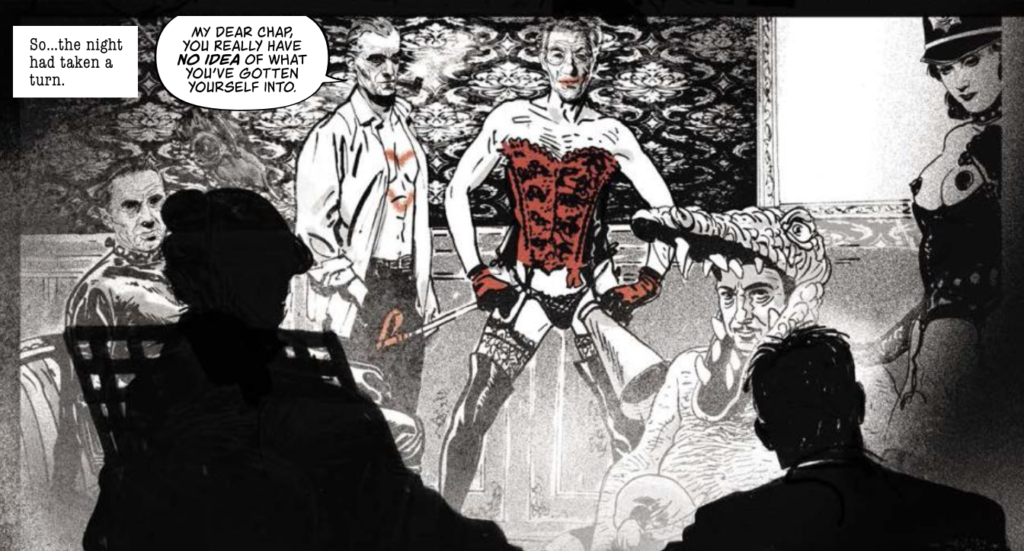
Sir Ian looking simply fabulous in ‘the corrupted, perverted and demonic party scene.’
Jimmy, your style throughout Hope has been obviously photo-realistic and you certainly don’t shy away from obvious likenesses for readers to pick up on. What was your thinking of the inclusion of so many real-life characters as well as characters with obvious likenesses of others?
JB: First off, I don’t consider my work on Hope to be ‘photo-realistic,’ that’s a term for art that tries to emulate or reproduce a photographic feel. My art is far from that, the line work is too loose and stylised to be considered photo-real. My objective is to create a kind of naturalistic authenticity.
Yes, apologies for that – that was lazy shorthand on my part! Stylised but naturalistic is far better!
JB: So the characters look like actual people (sometimes well-known people as you mention), but they don’t look like photographs. Anatomy is plausible, and the lighting/perspective etc. is firmly rooted in reality. This is essential I think to allow for the suspension of disbelief that is required to successfully create the ‘doomed diner’ that you mentioned.

Was the idea to include familiar faces and real-world characters something that was script based or was it more a case of it coming out in the discussions between you both?
JB: Guy often mentions people he wants our characters to “resemble” or at least reference. I usually take it literally and just go for it, but sometimes I play with the suggestions. For example Tiff, our film director, was described as being James Whale of Frankenstein fame. He was played in the excellent film Gods and Monsters by Sir Ian McKellen, so I cast him instead. On other occasions I’ll just add “actors’ for fun. In the doomed diner scene, Guy had Lauren Bacall and David Lynch, I thought it might be fun to have Arthur Mullard as the diner owner.
GA: McKellen has a far more interesting face than James Whale. I do occasionally imagine him having a conniption in the middle of WH Smiths though, shocked to see him, poured into a basque (and whatever else).
I usually cast all the parts, aye. Gloria Swanson – Billy Wilder’s back, Sunset Boulevard – was my suggestion for Norma. I even cast myself in the first reel, I thought it was about time given who Hope actually looks like!
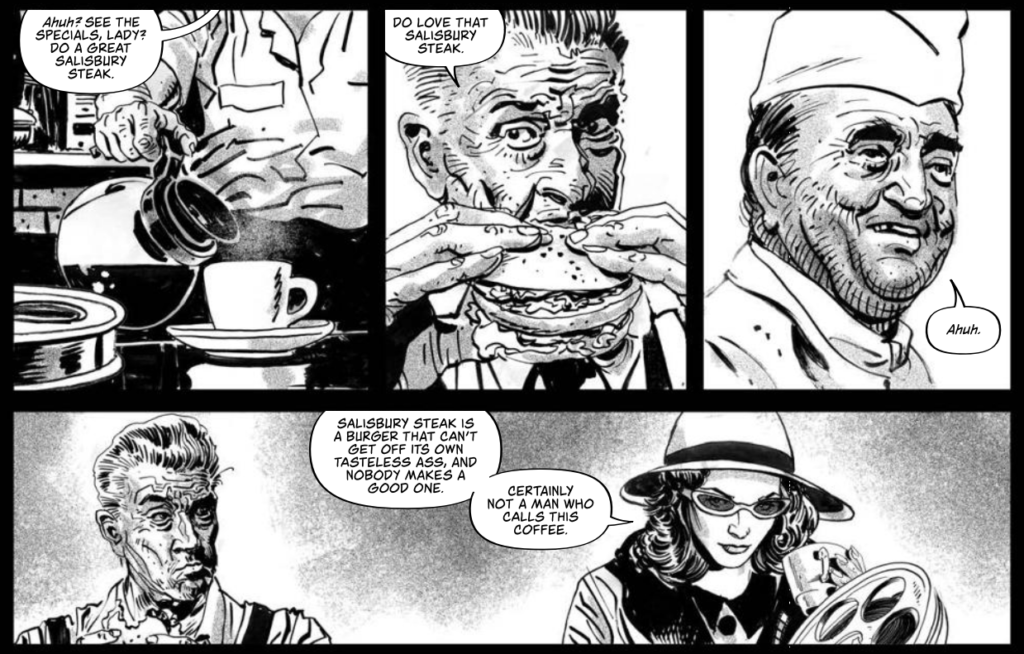
And on that point, as far as how you put the series together, is it still a case of ‘I wash, he dries,’ as you said back when I first talked to you about Hope back in 2017?
JB: More or less, but now I also do the ironing, often re-cutting scenes, moving and adding panels, taking different viewpoints etc. I would never dream of messing with the script, or doing anything that didn’t serve it 100% that is sacrosanct but I do see it as a script writer/director situation, with me being the director. Hopefully Guy agrees.
I’m not suggesting that I’m in charge, far from it, Guy’s scripts are the most important thing, but he graciously allows me the breathing room I need to do my best work, and tell his stories as best I can, as of course does the boss who actually runs the show- Tharg.
GA: I sort of agree! Strictly speaking you’re cinematographer I’d say. You’re lining up the camera, getting the coverage, choosing the angles, the frames. You’re the gaffer too, master of light.
I’ve always been very open with Jimmy that he should change things however he sees fit. The relationship between writer and artist varies a lot. I’ve worked with artists that really want to be led and, *whispers*, look… I don’t dislike that, as mentioned above I believe very strongly that any comic writer should be thinking of every visual aspect to a script, the angles, the shots, the framing… I have a very strong mental image of what each page should look like and there can be a real, transcendent pleasure in seeing that brought to life. I’ve also worked with artists who change things without discussion or – it sometimes seems – thought (you’ll get no names from me but there’s nothing that itches quite so much as a story falling apart in front of your eyes because the imagery has worked against the script and something vital has been lost).
The times a Jimmy page looks exactly like I’ve expected it to are rare. Extremely so. And that’s lovely too of course, because it’s Jimmy and I love him and he excites me.
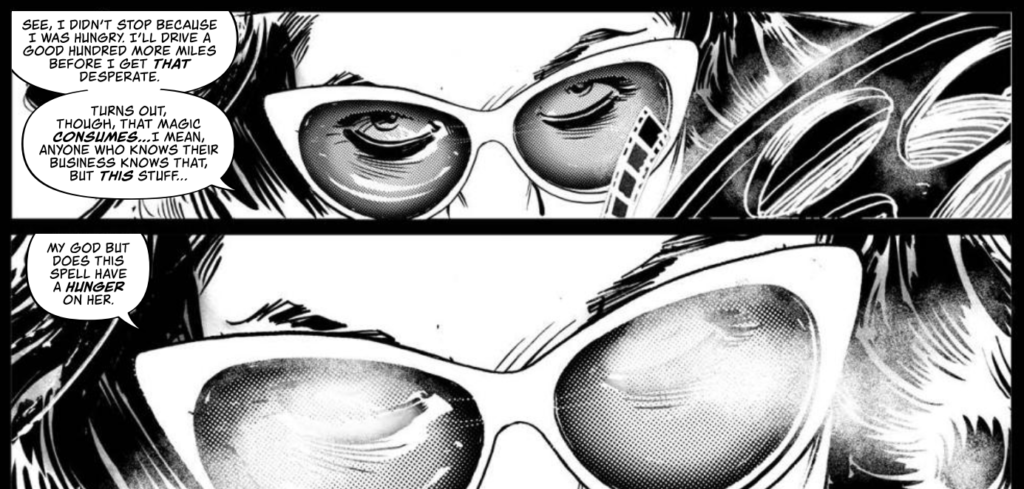
Back then Guy, you talked about leaving room in your scripts to let Jimmy play – with you sketching out thoughts and ideas for staging, albeit from a full script, but with more than enough leeway to let Jimmy add his own ideas.
After all this time, is that still the basic way you’re collaborating, or has the familiarity that comes with a long-running series bred comfort and shorthand?
JB: ‘Shorthand’?! Guy knows not the meaning of the word. His scripts are rich and full, and as interesting and enjoyable to read as the comic itself. In fact, they are often bloody hilarious, one day I dream of a mega, ‘absolute’ style edition of the collected Hope that includes Guy’s scripts, it’s criminal that so few folks get to see them.
>
Jimmy, thanks for sending some of your art along for us – how do you go about constructing your pages?
JB: Here’s something very rare, thumbnail layouts for Hope. Rare, because I don’t usually do any. My process rarely involves layouts or thumbnails for the pages. Instead, I compose the page from the disparate elements I have drawn, all separately as required.
I have no real idea of the final design of the page until I start composing. However, when I’m running late, or behind schedule (which is rather too often) I’ll produce very basic thumbnail layouts for Tharg so he can get them lettered. I’ve included some from Hope ITS 2 episode 3 here and the finished unlettered pages.
Although diabolically crude, I’m always surprised how much they look like the finished pages when viewed very small.

.
Now, I don’t think it’s pushing things to say that Hope looks like nothing else in the Prog and it’s been that way since we first saw the series. What have you both to say about the notion that 2000 AD is a still somewhere that is pushing boundaries in terms of being able to publish a weekly anthology that’s capable of putting out works such as Hope?
JB: that’s the beauty of 2000 AD, that it allows for such wild varying creative approaches.
It’s always been that way, long may it continue! I’m honoured and frankly amazed that I’m allowed to participate in and add to that legacy. It’s a great privilege, for which I’m incredibly grateful.
GA: It’s so essential isn’t it? This artform we’re all reveling in needs variety, it needs breadth, it needs a wider range of voices.
>
Finally, both of you, what’s coming up soon and not so soon from you? Both for Tharg and elsewhere.
JB: Well, not sure how much I can reveal, but Guy and I have pitched a couple of new series ideas to Tharg. We also have a creator owned project in the works. Guy may well wish to spill the beans here….
GA: Nah…
Drokk it!
JB: Other than that, I’m doing a lot of cover work, most notably for Dynamite in the US.
They have the rights to some wonderful properties, so Vampirella, Red Sonja and Bettie Page (to name but a few) have strutted across my drawing board of late. Most recently I created a set of 5 covers featuring Barbarella, something of a fanboy wish come true.
GA: As mentioned above I’m doing a weird little film. I’m writing and recording commentaries and documentaries about film for companies like Arrow (my wife, writer and genius Alexandra Benedict, and I have recently started recording commentaries together, Monkey and the Sex Queen, skipping their way through old classics like The Dunwich Horror. A new audio series is currently doing the pitching rounds and tomorrow I’ll be sat in a TV writer’s room for the first of a few sessions for a possible new show. I’m also writing a novel about a drive-in and the ghost of Orson Welles.
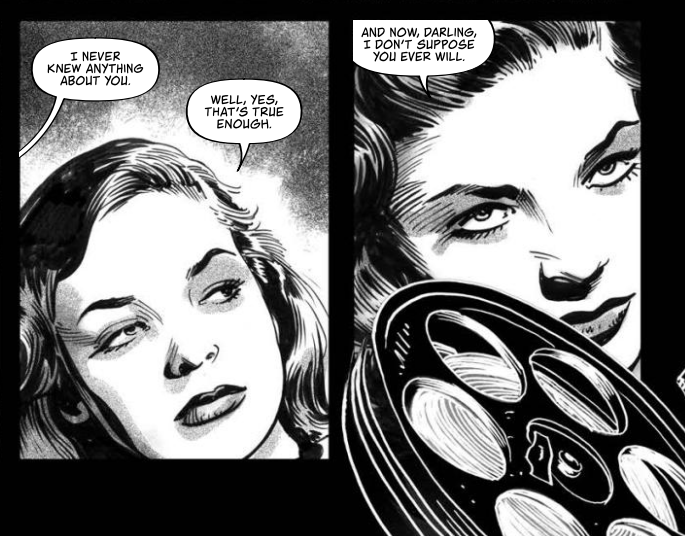
Thank you so much to Guy and Jimmy, one of the best double acts in comics! It was a pleasure chatting to them for this one. You can find our first chat about Hope… For The Future from 2017 right here.
You can find Hope… In The Shadows Reel Two running in the pages of 2000 AD right now. The series began with Reel One in Progs 2276-2279, 2281-2287, and 2289, and continued with Reel Two in Progs 2302-2305, 2307-2308, and 2310. Get it wherever Thrill Power is sold, including the 2000 AD web shop.
The previous Hope storylines were Hope… For The Future (Progs 2011-2016, 2044-2049 – collected as Hope… For The Future) and Hope… Under Fire (Progs 2150-2161).
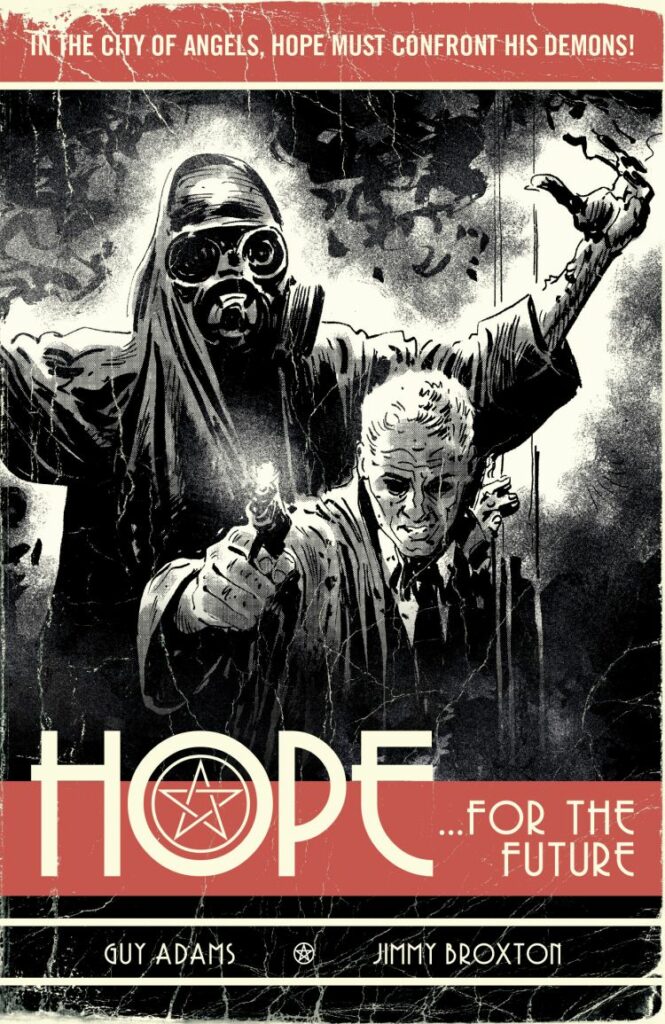
And now, as promised, the full-sized images of Jimmy’s art for Hope… In The Shadows Reel Two episode 3, pages 3, 4, and 5…
